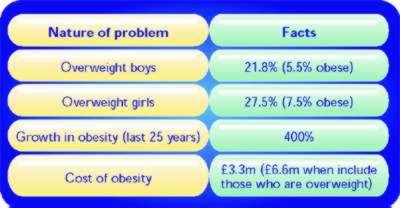
Governments often propose new initiatives, some of which turn out in the long run to be more successful than others. One key factor affecting the likelihood of an initiative’s eventual success is the amount of research, thought and planning that precedes its introduction.
This Case Study looks at the government’s National Healthy Schools Programme (NHSP) introduced in October 1999 and examines some of the planning procedures that have been involved in making sure that this programme is well structured and properly organised in advance of its delivery.
A Healthy School is one that is successful in helping pupils and students to do their best and build on their achievements, and which promotes a school ethos and environment that encourages a healthy lifestyle. It understands the importance of investing in health to assist in the process of raising levels of pupil achievement and improving standards. The Programme will lead to more structured health promotion in schools, with an emphasis on targeting the needs of local school populations of children and young people.
The NHSP is one of the means of achieving the government’s aim of supporting the public to make healthier and more informed choices in regard to their health. It makes sense for people to be healthier because this enables them to lead more enjoyable, active lives. It also makes economic sense, because preventing ill health is better and cheaper than having to spend money and time on curing health problems.

Healthy eating/physical activity are only two aspects of healthy schools. Others include emotional health and well-being (including bullying), sex and relationships education, drugs education (including alcohol and tobacco), personal social and health education, safety and Citizenship.
To create and implement any plan or programme it is necessary to create a clear planning framework.
Monitoring the environment
The environment consists of all those factors external to decision makers that they must consider when they make an important decision, introduce a new policy and deliver a programme.
In developing the NHSP, key external factors that needed to be considered included key changes taking place in society. Although people today are living longer (thanks to factors such as high quality water, cleaner fuels, and warmer, drier homes) society still faces some serious health issues.
Although we have better public health and treatment systems, increased affluence has brought new problems of its own. For example, the UK faces rising levels of obesity and marked increases in the number of overweight children.
- Nationally, about 1 boy out of every 5 aged 2-15 is overweight, and about one quarter of those boys who are overweight are severely overweight (obese).
- Nationally, more than one girl in every 4 is overweight, and again about one quarter of those girls are obese.
In the past 25 years, the incidence of obesity in the UK population has increased fourfold. It has brought with it associated health problems e.g. chronic heart disease, diabetes, kidney failure, back pain and psychological damage.

The cost of obesity is estimated at £3.3 billion per year. This cost doubles when we include the costs associated with people who are less severely overweight.
Key facts about obesity
Today, many children appear to have fewer opportunities for physical activity; more are overweight and some obese. Some commentators suggest that this is because children and young people are:
- eating more convenience and fast foods
- spending more time watching television or playing computer games
- spending less time being physically active because of an increase in car travel and heightened concern about the potential risks of unsupervised outdoor play.
Aims and objectives
The NHSP is funded by the government’s Department for Education and Skills and Department of Health. As the titles of these Departments suggest, they exist in order to steer activities in particular areas of the economy. These Departments are staffed by civil servants (government employees).

Clear aims and objectives are particularly important in the public sector because many programmes involve more than one Department, and involve millions of pounds of taxpayers’ money. Having clear aims and objectives helps to ensure that everyone involved in delivering the programme:
- understands the programme’s end purposes
- pulls in the same direction, and ‘sings from the same hymn sheet’
- spends the available funding in the most effective way to achieve aims and objectives.
An aim is the general purpose that an organisation seeks to achieve through programmes and activities. Aims can then be broken down into objectives. Usually, objectives are more precise definitions of the ends an organisation seeks to achieve.
Because the DfES and the Department of Health sponsor the NHSP, they are responsible for shaping its aims and objectives. The Programme’s key aims are to:
- Raise levels of achievement across the school population. Educated people tend to become more healthy, particularly when they understand the issues involved and how to live healthier lives.
- Reduce health inequality. The UK is still characterised by inequalities in the access that people have to healthier lifestyles. For example, the incidence of smoking, lack of exercise and unhealthy eating patterns are much higher among lower income groups and in poorer areas. Reducing inequality is a major issue for the current government. The government’s goal is to halve child poverty by 2010 and eradicate it by 2020.
- Promote social inclusion. Social inclusion is a policy that seeks to ensure that all members of our society enjoy benefits such as being able to live a healthier life. The current government has introduced policies to combat ‘exclusion’. Exclusion exists when some groups lack access to the benefits enjoyed by other citizens because they are too poor, lacking in education, unhealthy and so on.
Healthy schools can only really work if there is participation by pupils and students. Every healthy school should have a Task Group which pupils can join, or at least influence.
SMART objectives
Aims tend to be general whilst objectives are much firmer statements of purpose. It helps if these objectives are SMART. This acronym stands for:
- specific
- measurable
- achievable
- realistic (or relevant)
- time-related.
SMART objectives enable everyone involved in an organisation to:
- understand what is involved in meeting objectives
- know when objectives have been met.
For example, the Department of Health and the DfES cascade the objectives they set.
This can be illustrated by the Department of Health’s Spending Review 2004, Public Service Agreement, which set out to: ‘tackle the underlying determinants of health and health inequalities by halting the year-on-year rise in obesity among children under 11 by 2010.’

To achieve this objective, the NHSP set its own objective, that:’50% of schools to have been awarded Healthy Schools Status by 2006; the rest to be working towards the status by 2009‘. Clearly, this is a SMART objective.
Strategy
A strategy is a plan designed to implement sets of actions. It is therefore the means by which an organisation’s aims and objectives will be met.
The NHSP is the means through which the DfES and the Department of Health is looking to achieve its objectives in terms of creating Healthy Schools and healthier young people.

The strategy involves a two-pronged approach:
- Improving school children’s diet
- Encouraging more physical exercise.
Pupils need a wholly consistent message in schools. Schools are being encouraged to develop Healthy School policies that include planning the food curriculum for the year and determining how it can be built into all aspects of the curriculum e.g. Food Technology, Science, Citizenship, PE.
The whole school approach covers a range of activities, including:
- pupils and parents having considerable influence over the food that pupils are offered
- providing breakfast clubs. Schools providing breakfast should ensure that the food and drink available are consistent with an overall healthy diet
- offering high quality physical education and school sport and the promotion of physical activity as part of a lifelong healthy lifestyle message. This may include playground games and encouraging pupils to walk or cycle to school
- easy access to clean drinking water throughout the day
- healthy tuck shops, with the promotion of fresh fruit and vegetables
- vending machines that actively promote healthier options
- attractive dining rooms
- guidance about packed lunches and school visits
- school lunches that meet new nutritional standards and which also are attractive to pupils
- a school curriculum that teaches about nutrition and healthy eating, food storage and hygiene, and also cooking skills
- displays around the school that promote healthy eating and high standards of hygiene
- school programmes offering support on drug education, emotional health and wellbeing (including bullying), safety, sex and relationships education.
An example, of a practical step that has been taken to increase awareness of health related issues is the development of Personal Health Guides (PHGs) for children. These will be the foundation of personal health guides for life.
The health guides encourage children and young people to build health into the way they live their lives. In a child’s early life, the health guide, linked to and building on the child’s health record, will be developed and held by their parents or carers with advice and support from health professionals.
As they grow up, every child will assume responsibility for developing his/her own health goals with help from parents, school staff and health professionals. There will be opportunities to review plans at key transition points, such as starting school, moving to secondary school, or starting work.
Conclusion
The government regards the development of healthy citizens and a healthy society as an important priority.

The NHSP is a major vehicle for helping the government to meet important health objectives – in particular the government’s national target to reduce the increase in obesity among children under 11 in the context of a broader strategy to tackle obesity in the population as a whole. This objective is shared jointly by the government departments with responsibility for health, education and sport.
The establishment of clear aims and SMART objectives enables the government to implement clear, well focused strategies such as the NHSP. This programme is deliverable because it is relatively easy to communicate to everyone involved in making the strategy workable.
By creating an integrated set of aims, objectives and strategies it becomes possible for all the relevant parties to work together in a concerted way to help achieve a healthier society.
